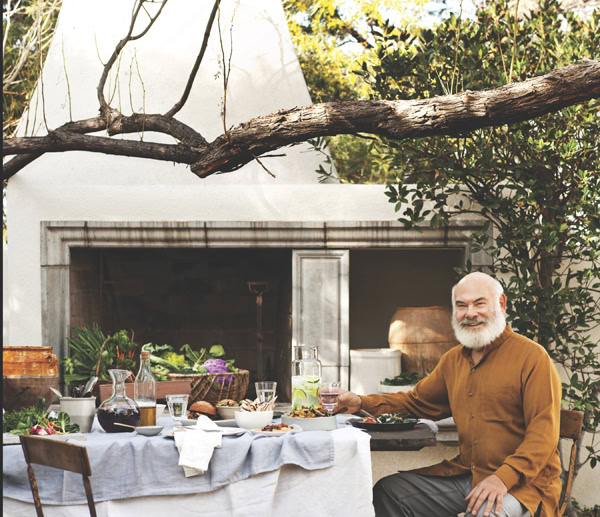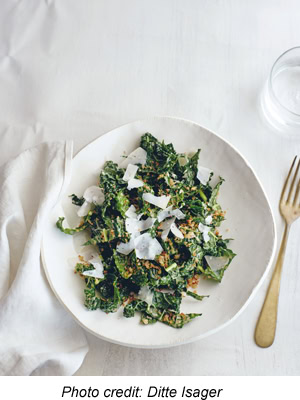Dr. Andrew Weil is a renowned leader in the field of integrative medicine, a healing-oriented practice that takes account of the whole person (body, mind, and spirit), including all aspects of lifestyle. It emphasizes the therapeutic relationship and makes use of all appropriate therapies, both conventional and alternative. Dr. Weil earned his undergraduate and medical degrees at Harvard, and is the founder and director of the Arizona Center for Integrative Medicine. He has also written 10 books and heads his own foundation. So, how does this work translate into restaurant menus and his newest book, True Food: Seasonal, Sustainable, Simple Pure
Dr. Wields connection to food began, when as a child, he would cook with his grandmother. As he matriculated, he found cooking as a way to decompress. His travels educated him about the foods and flavors of various cultures, all enhancing his culinary palate and further inspiring him think up new recipe ideas. In the book, Dr. Weil describes himself as someone who has never been a fan of eating out, preferring wholesome home-cooked food. But the concept of offering healthy, appetizing food at a restaurant became a reality with the founding of True Food Kitchen in Phoenix, Arizona, in 2008. (There are now five other locations including Scottsdale, Arizona, and Newport Beach, San Diego, and Santa Monica, California, and one in Denver, Colorado opens this month.)
The mission at True Food is twofold: dishes must be delicious and also promote diners well-being. Opening this new book offers a tantalizing look at Dr. Wields delicious food: 125 recipes in ten chapters spanning breakfast, appetizers, salads, soups and chilis, pasta, vegetables, meat, and seafood, drinks, desserts and basics. All are presented to show readers how easy it is to eat well at home.
As much as we have been enjoying cooking from his newest book we were even more excited to have the opportunity to connect with Dr. Weil over email for this Q&A.
OLDWAYS: For those who may not be familiar with the concept behind True Food the restaurant or the cookbook can you talk with us about how it all came to fruition
DR. WEIL: In some ways, it was a lifetime in the making. I grew up in Philadelphia, cooking with my grandmother. As a medical student in Boston, I found that creating great meals was just what I needed to relax after a long shift. For 40 years after that, I traveled all over the world and had the great privilege of eating the best dishes in dozens of countries. I should point out that best seldom meant most expensive some of the most memorable meals I’ve ever had were from street vendors in Africa, Latin America and Asia.
I combined this in-the-field experience with my ongoing study of the latest developments in nutrition science. I was determined to develop a repertoire of dishes that was both delicious and healthy. As it turned out, many of my go-to meals were interpretations of Asian mostly Japanese and traditional Mediterranean cuisines. These are the two healthiest types of food in the world, based on measures such as lifespan and incidence of chronic disease.
As I cooked for friends and family at my home in Tucson through the years, I got universal raves. I must have heard You’ve got to open a restaurant hundreds of times! Finally, in 2007, my business partner, Richard Baxter, arranged for me to meet a brilliant restaurateur, Sam Fox, who runs several restaurants in Arizona that I admire very much. I cooked for Sam, he loved the meal, and our partnership evolved from there. Sam brought in Michael Stebner, a talented chef who cooked in one of Sam’s restaurants, and Michael and I worked together intensively to create the menu.
The first True Food Kitchen opened in Phoenix in October of 2008. This was just as the recession was really hitting hard, and everyone said we were crazy to open in that environment. It was an immediate, runaway hit. Now, all five of our locations are doing wonderfully well, and many more are planned nationwide.
OLDWAYS: You bring up a point in the book about the excessive use of four ingredients in restaurants. Can you talk with us about how you were able to overcome these obstacles in your cooking (at the restaurant and at home) and still deliver delicious dishes
DR. WEIL: The four ingredients are sugar, salt, butter and heavy cream. In an essay in the book, Michael points out that these are culinary crutches often used by chefs to make their offerings more appealing.
The best way to stop relying on these simple, one-note flavors is to pay close attention to the cuisines of other countries, especially in Asia. Those cultures are adept and ramping up flavor with herbs, spices, fish and soy sauces and other healthy enhancers.
It’s also important to note that often, strong flavors are used to mask poor quality ingredients. Over-sugared or salted food may be on the verge of going bad, and the chef is attempting to hide this unfortunate fact. When your fruits, vegetables, fish, meats and dairy products are the freshest possible, they are naturally flavorful and need precious little adornment. There’s a great quote from Alice Waters that we have the wall of several of our locations, and that perfectly reflects our philosophy: Let things taste of what they are.
OLDWAYS: What do you think are the most important recommendations or strategies for readers who are searching for healthier menu options
DR. WEIL: When it comes to healthy eating, whether in a restaurant or at home, the most succinct advice I can give is: Avoid processed and manufactured food as much as possible. The closer a food is to its natural state, the more likely it is to be healthful.
To be a bit more specific, the epidemic of obesity and related diseases that we are seeing throughout the western world is, I think, largely the result of eating too much of three basic ingredients: flour, sugar and soybean oil. If people would cut way back on these three types of food, our health would be much better.
I find that there is great confusion out there about the proper role of fat in the diet. I have long recommended extra virgin olive oil, a monounsaturated fat, as the best source of dietary fat. Interestingly, it now seems increasingly clear that natural saturated fat that is, fat that is solid at room temperature, such as butter or the fat in a grass-fed steak is not a threat to coronary health. I think the low-fat mania that gripped this nation for several decades led to rampant over consumption of poor quality carbohydrates and widespread obesity. Putting more healthy fat back into the diet can help create satiety a feeling of fullness that can help in achieving and maintaining a stable weight. This is why I recommend consuming organic, full-fat dairy products.
OLDWAYS: In the book you talk about inflammation and the damage it can cause. What are of your top picks in terms of anti-inflammatory foods
DR. WEIL: That’s a big subject my best advice is to go to my website and check out the Anti-Inflammatory Food Pyramid. All of the foods you will see there can help to keep whole-body, inappropriate levels of inflammation in check.
To choose just one special example and highlight something that many Americans seldom consume I am a big fan of the spice turmeric. It has potent anti-inflammatory effects. One reason elderly villagers in India have far lower rates of Alzheimer’s disease than their American counterparts appears to be the turmeric that is part of their daily curries.
OLDWAYS: Being a recent kale convert, I love insights on Americans learning to love kale. For those who may be a bit intimidated by this great green monster, do you have any suggestions on how to begin to incorporate it into their diets
DR. WEIL: The best way I have found is via the Tuscan Kale Salad, the signature dish of True Food Kitchen. People who have never eaten kale and definitely never eaten raw kale become absolutely addicted to it. It offers two great advantages: it is simple to make, and unlike other salads, this one actually gets better the day after you make it the lemon juice works on the kales fibers and makes the leaves even more tender.
OLDWAYS: We would kick ourselves if we missed this opportunity. Can you give us permission to include one of your recipes in this blog post and on our website
DR. WEIL: Sure, here’s the Tuscan Kale Salad recipe. You can see Michael Stebner and me make it on my website.
Ingredients:
4-6 cups kale, loosely packed, sliced leaves of Italian black (Lacinato, dinosaur, cavolo nero) midribs removed
juice of 1 lemon
3-4 tablespoons extra-virgin olive oil
2 cloves garlic, mashed
salt & pepper, to taste
hot red pepper flakes, to taste
cup grated Pecorino Toscano cheese (Rosselino variety if you can find it) or other flavorful grating cheese such as Asiago or Parmesan
½ cup freshly made bread crumbs from lightly toasted bread
Instructions:
Whisk together lemon juice, olive oil, garlic, salt, pepper, and a generous pinch (or more to taste) of hot red pepper flakes.
Pour over kale in serving bowl and toss well.
Add of the cheese and toss again.
Let kale sit for at least 5 minutes. Add bread crumbs, toss again, and top with remaining cheese.









Leave a comment